


|
On Christmas Eve, an eccentric schoolmaster in the little town of Arroyo, W. Va., was brutally murdered. He was found with his head cut off, crucified on a signpost at a crossroads near his house. In the course of the next year, three other men, in various places, were found with their heads cut off, crucified likewise in the form of a T. Everyone working on the case, including Ellery Queen, was completely baffled. But Ellery had the feeling that there was one clue he didn't possess which would suddenly bring the whole tangled and eerie puzzle into line and give him the solution. That clue came to him with the fourth murder. This novel has justly been called "Ellery Queen's weirdest adventure." A good many fans have gone further; they consider it his very best story. |
|
| "Another bull's eye for Ellery Queen" -- Philadelphia Inquirer | |
 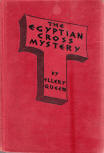  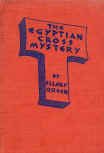 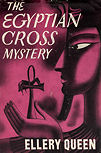  |
|
| Above left to right: The first books published sometimes had identical front covers. The spine of the books/dust cover differ only in the publisher's logo. Both dust cover and hard cover for Stokes, Grosset & Dunlap & Triangle Books. (Click on the covers to see the differences) * | |
| The Evening Star -
"New Books at Random" by M. G. January 17. 1933 "For fantastic conception and design in the business of weaving the fabric for tales of mysterious murder the laurels go to Mr. Ellery Queen. When The Greek Coffin Mystery came along his readers felt that this time he had reached the high point of creating hair-raising episodes and weird situations, but apparently there is no such thing as a limit to the imaginative ability of this welcome narrator of gory events and the brilliant detection of their instigators or perpetrators. 'The Egyptian Cross Mystery' is distinctive enough in its very title to arouse the curiosity, and when the name of Ellery Queen is observed as its author—then that settles the question of "What shall I do tonight, or read?" Down in West Virginia, where the mountains crowd upon each other in massive dignity, and where settlements of human habitation are few and far between Mike Orkins and Ol' Pete, riding in from the hills in the gray and eerie dawn of Christmas day toward the little village of Arroyo, come upon a gruesome find. From the weather beaten signpost at the crossroads, half a mile or so from the town, hangs the decapitated body of a man both arms outstretched with the hands nailed to the tips of the crossbar of the sign and the ankles nailed to the center post. Investigation brings identification of the body as that of the somewhat eccentric schoolmaster of the region, and also the knowledge that his slow-witted man-servant is missing. Ellery Queen is attracted to the case because of one startling feature which appears consistently in all phases of the affair. The conjunction of the road formed a huge letter “T"; the signpost to which the body was nailed presented to the eye a large "T”; the body of the crucified man, minus its head, resembled a "T,” and on the door of the schoolmaster’s house, not far from the crossroads, the letter “T” had been scrawled by the murderer in the blood of his victim. Here is the groundwork for an Ellery Queen murder case which for baffling plot, fantastic design and elusive detection breaks the record. However closely the reader may apply that cold logic recommended by the author as the "analytico-deductive method" of detection, the solution of the West Virginia case and the two "T” murders which follow it remains as much of a mystery as the author himself—and, by the way, there is an interesting photograph of him on the inside flap—until his own brilliant application of his particular brand of logic brings the climax. A couple of hours of breath-taking shudders and chills for those who love them." |
|
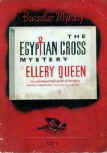 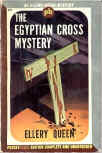 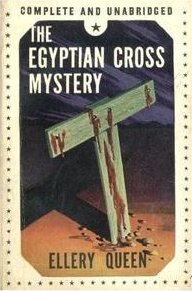     |
|
|
Ellery Queen’s The Egyptian Cross Mystery (1932) is
widely regarded as one of the author’s most bizarre and haunting works, a
novel that even contemporary reviewers called “Ellery Queen’s weirdest
adventure.” The story opens with a macabre discovery in the remote West
Virginia village of Arroyo, where, on Christmas morning, the decapitated
body of an eccentric schoolmaster is found crucified upon a roadside
signpost. His arms are nailed to the crossbar, his ankles to the upright,
the tableau forming a grotesque “T.” The man’s slow-witted servant has
disappeared, and the only other immediate clue is the letter “T” scrawled in
blood on the victim’s own door. From the very first scene, Ellery Queen is
drawn into a crime that seems at once ritualistic, symbolic, and
unfathomably cruel. But this is only the beginning. Over the course of the following year, a series of equally brutal killings occurs, each echoing the first: men are murdered, their heads removed, and their bodies crucified in the shape of a “T.” The recurrence of this strange symbol—the crossroads, the signpost, the body itself, all reinforcing the image—suggests a deeper pattern, but the meaning eludes both police and detective alike. Ellery pursues the trail from the rural backwoods of West Virginia to Long Island and New York City, where a wealthy rug importer falls victim to the same fate. His investigation reveals connections not only among the victims, but also to a sun-worshipping nudist cult that seems shadowed by mystery and menace. As the killings continue, it becomes increasingly clear that religious and symbolic elements are central to the murders, but only with the fourth death does Queen grasp the missing clue that allows him to untangle the enigma. The plot is both intricate and deliberately disorienting, constructed around a mass murderer who is not only fiendishly clever but also driven by a very particular, if horrifying, purpose behind his choice of decapitation. The novel contains nearly all of the classic Ellery Queen devices: the challenge to the reader, the reliance on logic and deduction, and a string of carefully planted clues that make the solution theoretically attainable, though extremely difficult to reach. It is worth noting that in this installment, Inspector Queen and Djuna are largely absent, leaving Ellery to stand alone against the puzzle. |
|
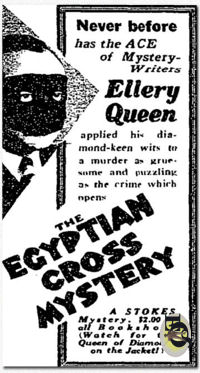 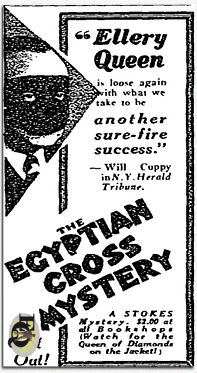 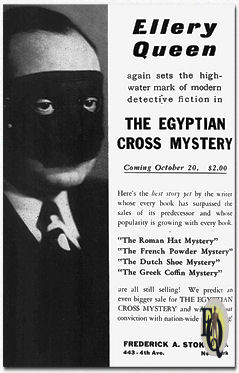 Above left and right : Add for Stokes Mystery The Egyptian Cross Mystery - "Watch for the Queen of Diamonds on the Jacket!" with on the right the page size advertisement for The Publishers' Weekly from September 1932 (!) |
|
|
Critics at the time praised the novel’s inventiveness and atmosphere.
The
Philadelphia Inquirer called it “another bull’s eye for
Ellery Queen,” while
The Evening Star marveled at its “fantastic conception and design,”
emphasizing the eerie mood of the Appalachian setting and the shocking
imagery of crucifixion and blood-marked symbols. The America review
acknowledged the strength of the construction and the fairness of the cluing,
though it did remark that the murders were “unnecessarily gruesome”—a point
that modern readers, accustomed to graphic crime fiction, may not find
troubling. Some readers have compared its structure and themes to
John
Dickson Carr’s The Three Coffins, with both novels involving hidden
identities, old crimes resurfacing, and brothers of Eastern European descent
who are finally caught up by revenge.
(Grobius Shortling) Among Ellery Queen enthusiasts, The Egyptian Cross Mystery often vies with The Greek Coffin Mystery for the title of the best of the early period novels. While some prefer the intellectual elegance of The Greek Coffin Mystery, many regard Egyptian Cross as unmatched in its atmosphere, boldness, and sheer strangeness. It belongs to Queen’s “national” series—so named because each book of the period carried the name of a country/city—and marked one of the last such experiments before the authors shifted toward Hollywood projects. Still, its legacy endures: a chilling blend of religious symbolism, ritual murder, and deductive brilliance that remains one of the high points of early American detective fiction. |
|
|
It was only later that he got back into really bizarre situations, without an excess of whimsy - and those were sometimes ghostwritten by Avram Davidson (And on the Eighth Day is mind-blowing, and in a way complements this book). A conclusion not that far fetched as it becomes more and more clear that religious elements are more than abundant in all the great Ellery Queen classics. Still difficult to choose between this one and The Greek Coffin. It may come second ... but it great second it is! |
|
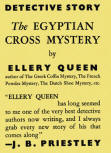 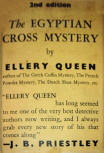 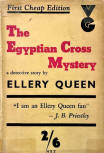 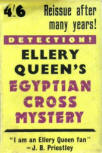 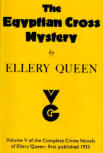    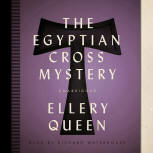  |
|
| America: A Catholic Review of
the Week -
January 14. 1933 "Ellery Queen has his troubles with 'The Egyptian Cross Mystery' (Stokes. $2.00). Within six months’ time, the bodies of two men are discovered, beheaded and crucified—one a school teacher in a small West Virginia village, the other a wealthy rug importer in New York. Ellery Queen discovers the connection between the two, and then directs the search for the murderer. The plot is well assembled, presenting an intricate problem to the armchair detective. And if he carefully follows the story, sufficient clues are given to enable him to answer the challenge of the author as to “ Who is the murderer?” and prove it as well—but it decidedly is not easy. A criticism that should be made is that the murders are unnecessarily gruesome. But perhaps this will not worry the modern reader accustomed to blood-curdling scenes in the modern movies." |
|
|
Elements for "The Game" There is a challenge to the reader included. |
|
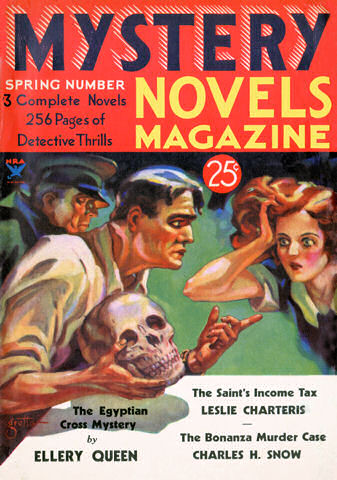 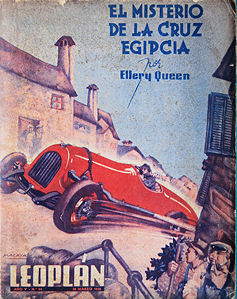 "Proof" of the keen
commercial brain of the cousins. Pictured left: the publication of the story in the Spring
of 1934 in Mystery Novels Magazine. Pictured right: the publication
in Argentian Magazine Leoplan (March 1938) "Proof" of the keen
commercial brain of the cousins. Pictured left: the publication of the story in the Spring
of 1934 in Mystery Novels Magazine. Pictured right: the publication
in Argentian Magazine Leoplan (March 1938) |
|
|
|
|
Other articles on this book (1) Reading Ellery Queen Jon Mathewson (Jul 2013) (2) Mysteries Ahoy Aiden Brack (Jul 2018) (3) Crucifixion of a Dead Man Ho-Ling (May 13. 2013) (4) Nick Cordillo (Sep 6. 2021) (5) Ramblings of the Golden Witch Umineko (Aug 28. 2016) (6) My Reader's Block Bev Hankins (April 30. 2021) |
|
|
*
Interested readers should know
that the icons/covers
of books, used throughout the
website have extra
descriptions/information not
included in the text on the same
page. Pointing your cursor at
the icon/cover used to reveal
this extra information. To achieve the same effect Firefox users can install an add-on called 'Popup ALT Attribute'. When installed pointing your cursor at an icon/cover results in showing you the details or additional information. |
|
Copyright © MCMXCIX-MMXXV Ellery Queen, a website on deduction. All rights reserved. |